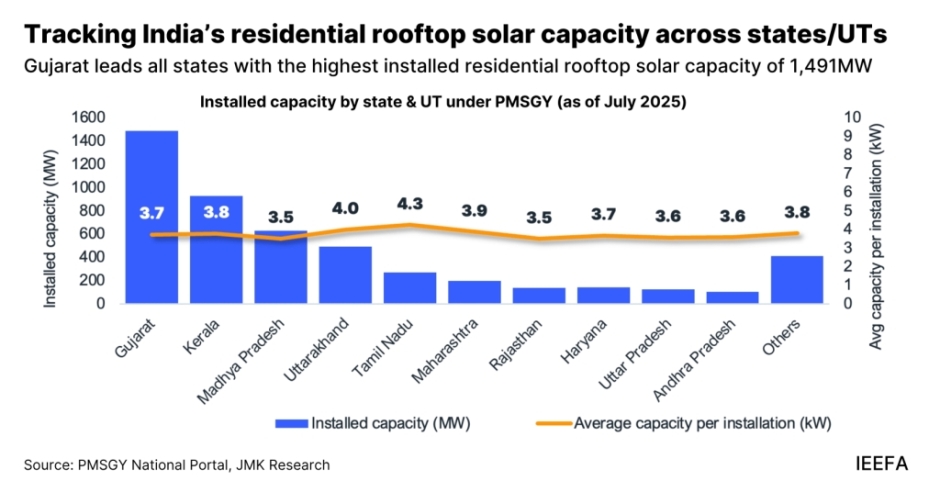India’s rooftop solar initiative, the Pradhan Mantri Surya Ghar Yojana (PMSGY), has accelerated the adoption of residential solar systems, adding nearly 4.9 gigawatts (GW) of capacity in just over a year since its launch, according to a new report by the Institute for Energy Economics and Financial Analysis (IEEFA) and JMK Research & Analytics.
As of July 2025, the PMSGY program has received more than 57.9 lakh applications for residential rooftop solar installations, demonstrating strong nationwide interest in household-level clean energy adoption.
However, despite this momentum, only 13.1 percent of the scheme’s target of 1 crore installations and 14.1 percent of the allocated INR 65,700 crore (USD 7.5 billion) in subsidies have been disbursed as of July 2025. This slow conversion rate highlights persistent challenges in scaling rooftop solar to meet the government’s FY2027 target of 30GW.
Gujarat Leads in Rooftop Solar Adoption
Under PMSGY, Gujarat has emerged as the frontrunner with an installed capacity of 1,491MW, followed by Maharashtra, Uttar Pradesh, Kerala, and Rajasthan. These five states together contribute 77.2 percent of the total installed capacity of 4,946MW under the scheme.
“PMSGY has steadily expanded its policy framework to accelerate residential rooftop solar adoption. Since 2024, it has implemented a nationwide capacity-building program to train over three lakh individuals and strengthen the ecosystem for vendors, utilities, and financiers,” said Jyoti Gulia, Founder of JMK Research.
Innovative Policies Driving Rooftop Solar Growth
The scheme’s “Innovative Projects” component provides grants covering up to 60 percent of project costs to support pilot projects and new business models. Additionally, a digital Domestic Content Requirement (DCR) ensures verified use of locally manufactured solar modules, promoting domestic industry growth.
States and Union territories are also being encouraged to create solar cities and model solar villages to promote decentralized clean energy adoption.
Barriers: Low Awareness, Financing Gaps, and Supply Chain Issues
Despite progress, low consumer awareness, limited access to finance, and outdated perceptions of high upfront costs continue to impede rooftop solar adoption—especially in rural regions, said Prabhakar Sharma, Senior Consultant at JMK Research.
The report also highlights fragmented supply chains for critical components such as solar panels, inverters, and mounting structures, causing project delays.
“Establishing clear, time-bound rooftop solar capacity targets at the state level is essential for creating a coherent vision and ensuring effective policy execution,” added Vibhuti Garg, Director, IEEFA South Asia.
Strengthening Implementation and Consumer Support
While a grievance redressal system has been established under PMSGY, its reach and efficiency remain limited. Aman Gupta, Research Associate at JMK Research, suggested creating district-level escalation mechanisms to address issues such as subsidy delays, portal errors, and data mismatches.
To enhance conversion rates from applications to installations, the report recommends setting up state- and district-level facilitation cells to guide consumers through subsidy claims and installation procedures.
The report suggested that standardized plug-and-play rooftop solar kits—including pre-assembled modules, inverters, and mounting systems—can significantly reduce project delays and improve quality assurance.
Outlook: Streamlined Systems Key to Long-Term Success
The success of the Pradhan Mantri Surya Ghar Yojana depends not only on subsidy distribution but also on institutionalizing efficient digital processes, standardized solutions, and consumer-centric support systems.
As India pushes toward its 30GW rooftop solar goal by FY2027, enhancing coordination among states, financiers, and consumers will be crucial to achieving sustainable growth in the residential solar segment.
Baburajan Kizhakedath

